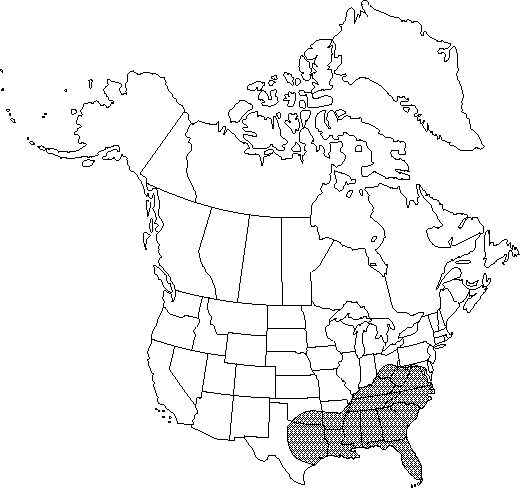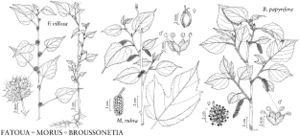Difference between revisions of "Fatoua villosa"
Bot. Mag. (Tokyo) 4: 516. 1927.
FNA>Volume Importer |
imported>Volume Importer |
||
| (7 intermediate revisions by 2 users not shown) | |||
| Line 10: | Line 10: | ||
|special_status={{Treatment/ID/Special_status | |special_status={{Treatment/ID/Special_status | ||
|code=F | |code=F | ||
| − | |label= | + | |label=Illustrated |
}}{{Treatment/ID/Special_status | }}{{Treatment/ID/Special_status | ||
|code=I | |code=I | ||
|label=Introduced | |label=Introduced | ||
}} | }} | ||
| − | |basionyms={{Treatment/ID/ | + | |basionyms={{Treatment/ID/Basionym |
|name=Urtica villosa | |name=Urtica villosa | ||
|authority=Thunberg | |authority=Thunberg | ||
| + | |rank=species | ||
| + | |publication_title=Fl. Jap., | ||
| + | |publication_place=70. 1784 | ||
}} | }} | ||
|synonyms= | |synonyms= | ||
| Line 27: | Line 30: | ||
}}<!-- | }}<!-- | ||
| − | --><span class="statement" id="st- | + | --><span class="statement" id="st-undefined" data-properties=""><b>Herbs,</b> to ca. 8 dm. <b>Stems</b> erect, branched, pubescent with hooked trichomes. <b>Leaves</b>: stipules linear to linear-lanceolate, 1.8-2.5 mm; petiole 1-6 cm, often ± as long as leaf blade. <b>Leaf</b> blade to 2.5-10 × 1-7 cm, papery, base cordate to truncate, margins crenate-dentate, apex acute to acuminate; surfaces abaxially and adaxially appressed-hirsute. <b>Inflorescences</b> cymes, dense, 4-8 mm wide, subtended by narrow bract; peduncle 1-2 cm. <b>Flowers</b> light green, staminate and pistillate in same cyme. <b>Staminate</b> flowers: calyx campanulate; stamens exserted. <b>Pistillate</b> flowers: calyx boat-shaped; ovary globose, puberulent, somewhat depressed in axis; style reddish purple, filiform. <b>Achenes</b> white, oval, 3-angled, ca. 1 mm, minutely muricate, with 2 triangular, membranous appendages. <b>Seeds</b> explosively expelled.</span><!-- |
-->{{Treatment/Body | -->{{Treatment/Body | ||
| Line 33: | Line 36: | ||
|habitat=Disturbed sites | |habitat=Disturbed sites | ||
|elevation=0-300 m | |elevation=0-300 m | ||
| − | |distribution=Ala.;Ark.;Fla.;Ga.;Ky.;La.;Md.;Miss.;Mo.;N.C.;Ohio;Okla.;S.C.;Tenn.;Tex.;Va.;W.Va.;West Indies (Bahamas);native to Asia | + | |distribution=Ala.;Ark.;Fla.;Ga.;Ky.;La.;Md.;Miss.;Mo.;N.C.;Ohio;Okla.;S.C.;Tenn.;Tex.;Va.;W.Va.;West Indies (Bahamas);native to Asia. |
| − | |discussion=<p>Fatoua villosa was first reported for North America from Louisiana by J. W. Thieret (1964). It has become widespread in the eastern and lower midwestern states where it often occurs as a weed in greenhouses and disturbed sites. Apparently it spreads from the distribution of horticultural materials.</p> | + | |introduced=true |
| + | |discussion=<p><i>Fatoua villosa</i> was first reported for North America from Louisiana by J. W. Thieret (1964). It has become widespread in the eastern and lower midwestern states where it often occurs as a weed in greenhouses and disturbed sites. Apparently it spreads from the distribution of horticultural materials.</p> | ||
|tables= | |tables= | ||
|references= | |references= | ||
| Line 43: | Line 47: | ||
-->{{#Taxon: | -->{{#Taxon: | ||
name=Fatoua villosa | name=Fatoua villosa | ||
| − | |||
|authority=(Thunberg) Nakai | |authority=(Thunberg) Nakai | ||
|rank=species | |rank=species | ||
| Line 53: | Line 56: | ||
|habitat=Disturbed sites | |habitat=Disturbed sites | ||
|elevation=0-300 m | |elevation=0-300 m | ||
| − | |distribution=Ala.;Ark.;Fla.;Ga.;Ky.;La.;Md.;Miss.;Mo.;N.C.;Ohio;Okla.;S.C.;Tenn.;Tex.;Va.;W.Va.;West Indies (Bahamas);native to Asia | + | |distribution=Ala.;Ark.;Fla.;Ga.;Ky.;La.;Md.;Miss.;Mo.;N.C.;Ohio;Okla.;S.C.;Tenn.;Tex.;Va.;W.Va.;West Indies (Bahamas);native to Asia. |
|introduced=true | |introduced=true | ||
|reference=None | |reference=None | ||
|publication title=Bot. Mag. (Tokyo) | |publication title=Bot. Mag. (Tokyo) | ||
|publication year=1927 | |publication year=1927 | ||
| − | |special status= | + | |special status=Illustrated;Introduced |
| − | |source xml=https:// | + | |source xml=https://bitbucket.org/aafc-mbb/fna-data-curation/src/2e0870ddd59836b60bcf96646a41e87ea5a5943a/coarse_grained_fna_xml/V3/V3_4.xml |
|genus=Fatoua | |genus=Fatoua | ||
|species=Fatoua villosa | |species=Fatoua villosa | ||
| − | |||
| − | |||
| − | |||
| − | |||
| − | |||
| − | |||
| − | |||
| − | |||
| − | |||
| − | |||
| − | |||
| − | |||
| − | |||
| − | |||
| − | |||
| − | |||
| − | |||
| − | |||
| − | |||
| − | |||
| − | |||
| − | |||
| − | |||
| − | |||
| − | |||
| − | |||
| − | |||
| − | |||
| − | |||
| − | |||
| − | |||
| − | |||
| − | |||
| − | |||
}}<!-- | }}<!-- | ||
-->[[Category:Treatment]][[Category:Fatoua]] | -->[[Category:Treatment]][[Category:Fatoua]] | ||
Latest revision as of 21:48, 5 November 2020
Herbs, to ca. 8 dm. Stems erect, branched, pubescent with hooked trichomes. Leaves: stipules linear to linear-lanceolate, 1.8-2.5 mm; petiole 1-6 cm, often ± as long as leaf blade. Leaf blade to 2.5-10 × 1-7 cm, papery, base cordate to truncate, margins crenate-dentate, apex acute to acuminate; surfaces abaxially and adaxially appressed-hirsute. Inflorescences cymes, dense, 4-8 mm wide, subtended by narrow bract; peduncle 1-2 cm. Flowers light green, staminate and pistillate in same cyme. Staminate flowers: calyx campanulate; stamens exserted. Pistillate flowers: calyx boat-shaped; ovary globose, puberulent, somewhat depressed in axis; style reddish purple, filiform. Achenes white, oval, 3-angled, ca. 1 mm, minutely muricate, with 2 triangular, membranous appendages. Seeds explosively expelled.
Phenology: Flowering summer–fall.
Habitat: Disturbed sites
Elevation: 0-300 m
Distribution

Introduced; Ala., Ark., Fla., Ga., Ky., La., Md., Miss., Mo., N.C., Ohio, Okla., S.C., Tenn., Tex., Va., W.Va., West Indies (Bahamas), native to Asia.
Discussion
Fatoua villosa was first reported for North America from Louisiana by J. W. Thieret (1964). It has become widespread in the eastern and lower midwestern states where it often occurs as a weed in greenhouses and disturbed sites. Apparently it spreads from the distribution of horticultural materials.
Selected References
None.
